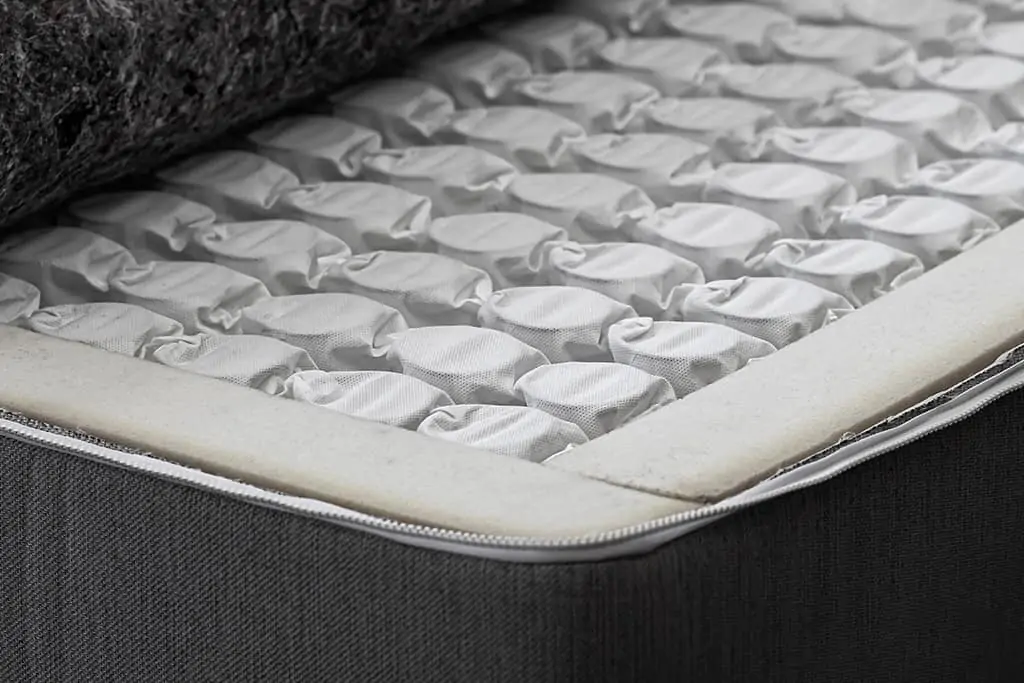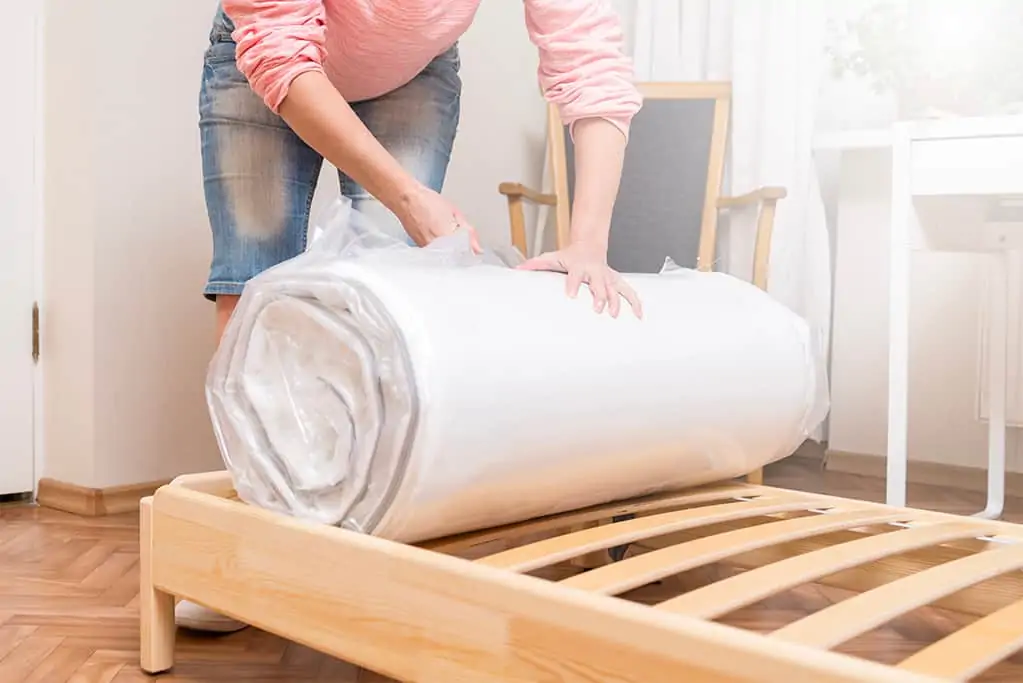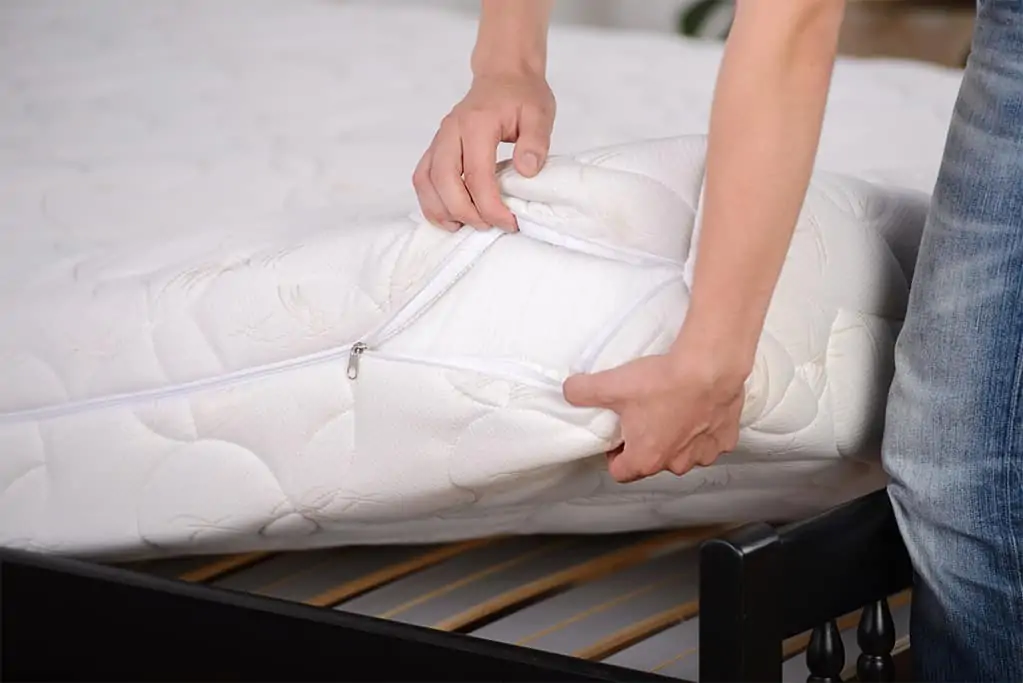Discover if a box spring is necessary for your kid’s bed. Explore box spring alternatives and bed frames like platform beds, slats, and bunkie boards.
The need for a box spring depends on the kind of mattress and bed frame you have. Some bed frames already have slats or a platform to support the mattress. While other types of beds might require a box spring or a similar alternative such as bunkie board or plywood. Read on to learn about which kid’s beds need box springs and how to determine if you need one.
If you’re getting a new mattress for your kid or transitioning your child into a grown-up bed, the question of box springs might arise. Do you really need to add a box spring under the mattress?
I had trouble deciding which mattress (innerspring or foam) to get my children because I didn’t know if I should buy a box spring. So, I did the research, and now I’ve collected all the information you’ll need to see if you’re making that choice too.
In this article, you’ll learn which bed requires a box spring. From baby cribs to bunk beds, you’ll know if your child’s bed or mattress needs a box spring base. I’ll also discuss the advantages over other mattress supports and even some DIY alternatives.
This article will cover the following:
So, let’s assess the need for a box spring together, and I’ll share my findings with you.
Uncertain about which mattress to get? Take a look at this list of the best kid’s mattresses. I have put lots of hours into this guide, and you’ll find the ideal mattress for your child!
Assessing the Need: How Do You Know if a Bed Needs a Box Spring?

I was confused when I first looked into whether my kids needed box springs. But after some research and talking to other parents, I found some key signs that might indicate a box spring is necessary for your child’s bed.
Signs That Your Child’s Bed Might Require a Box Spring
- Manufacturer’s Recommendations: The best way to know if your child’s bed needs a box spring is to check the manufacturing information and warranty for the mattress. If they say a box spring is required, it’s probably for a good reason.
- Type of Mattress: Figure out what size mattress your child sleeps on. If it’s a crib bed, a box spring is probably unnecessary, as you’ll read later. However, for some larger beds, you will need one. It will also depend on the type of mattress your child uses, like innerspring or foam, and the bed frame.
- Bed Frame Needs Additional Support: A bed frame may need extra support to hold the mattress properly. Here are some examples of bed frames that do require a box spring:
– Collapsible frames
– Those with no foundation surface
– Distantly-spaced slats - Child’s Specific Sleep Requirements or Preferences: Every child is unique, and so are their sleep needs. If your child has specific comfort preferences or requires extra support due to health reasons, a box spring might be beneficial.
Now that we’ve explored the signs that indicate a box spring is necessary let’s look at the flip side.
Indicators That a Box Spring May Not Be Necessary
- Sufficient Support from Bed Frame: Some bed frames are designed to offer enough support without a box spring. Here are some examples of bed frames that do not need a box spring:
– Platforms
– Reinforced metal frames
– Solid base surface or closely-spaced slats - Mattress Designed for Use without Box Spring: Some mattresses, like memory foam or latex ones, are specifically designed to work well without a box spring. My oldest’s memory foam mattress is a great example; it sits perfectly on a slatted base, saving us money and space.
Here’s the common question I came across while researching for this guide.
Do I need a box spring if I have slats?
Since the slats are close together and properly secured, you do not need a box spring with slats. The only time it would be necessary is with metal slats or slats that are far apart because your child’s mattress can sag through the open spaces.
Do I need a box spring with a platform bed?
Your child’s platform bed does not need a box spring. Platform beds are designed to be of the appropriate height and support. A platform bed is a bed frame with a solid or slatted surface for the mattress to sit on. The bottom is usually around 5-12 inches in height, giving your child’s bed the necessary lift.
Do you need a box spring with a bed frame?
You do not need a box spring if the bed frame has a solid bottom surface. Platforms bed frame or bed with closely-spaced slats does not require a box spring.
There are a variety of children’s bed frames of different styles, materials, and support. Here’s the type of bed frame that does or does not require a box spring.
Do bunk beds need box springs?
Bunk beds do not require a box spring. Moreover, they can be dangerous if used on a bunk bed. Box springs are too bulky for a bunk bed and will lift the mattress too high. In addition, the guard rails around the bunk bed will become unsafe if you add a box spring to a bunk bed.
Do toddler beds need box springs?
It depends on the type of bed your toddler sleeps on. If your toddler is still in a crib or a bed designed for a young infant, they will likely not need a box spring.
Cribs and toddler beds are designed with supportive mattresses at the correct height. With that, adding height or keeping the mattress in place isn’t necessary.
You might need a box spring if your toddler sleeps on a twin, full, or queen bed. Keep reading to learn if that applies to you.
Do cribs need box springs?
Cribs do not need box springs. They are designed to be used with a specific mattress, and the bottom surface of crib beds is very supportive. Adding a box spring to a crib can be dangerous because the crib frame is not designed for it.
Do twin bunk beds need box springs?
As with regular bunk beds, a box spring is unnecessary for a twin bunk bed. It can even be dangerous because the structure is not designed for use with one. However, my kids love sleeping in twin bunk beds on vacations and sleepovers! They’re already cozy enough without added height, so extra elevation is unnecessary.
Do innerspring mattresses need a box spring?
Older innerspring mattresses need a box spring, but newer models do not normally require one. Most new innerspring mattresses don’t need one because they are designed to be supportive on their own. However, Looking at the manufacturer information for your child’s mattress is still important.
Is it bad to sleep without a box spring?
If your child’s bed is designed for use with a box spring, you must use it. Sleeping without a box spring on the wrong bed is a bad idea. In some cases, it can cause back pain or discomfort and shorten the life of the mattress. Moreover, some beds become an entrapment hazard if not used with a box spring.
The bottom line is it’s only bad for your child to sleep without a box spring if their bed is designed for use with one.
Does a box spring make a bed more comfortable?
A box spring will only make a bed more comfortable if the mattress is designed for it. If a bed doesn’t require one, adding it will add too much firmness. Waking up to a cranky little one who didn’t get enough sleep should be avoided at all costs!
Now that we’ve cracked the code, let’s explore the alternatives to box springs we should consider!
Alternatives to Box Springs: What can I use instead of a box spring for Kid’s Beds?

There are tons of options for supporting materials to use instead, like slats, bunkie boards, or DIY options. Here are some of the best alternatives, DIY ideas, and their benefits. These might be the solutions you’re looking for!
- Platform Beds: Platform beds are typically made from wood or metal. Providing a sturdy and supportive base for the mattress. The flat and solid surface prevents the mattress from sagging. Which eliminates the need for a box spring. Platform beds are a great option for children because they are lower to the ground, making it easier for them to get in and out of bed. Additionally, the design allows for more storage space underneath.
- Slatted Bases: Slatted bases consist of wooden or metal slats evenly spaced across the bed frame. The slats are flexible and can slightly adjust to the weight of the mattress. This design doesn’t require a box spring because the slats offer ample support for the mattress. Plus, it allows better airflow around the mattress and helps regulate temperature for a comfortable night’s sleep. Slatted bases are a good option for children because they accommodate various mattress types, including memory foam and latex.
- Adjustable Bed Frames: Adjustable bed frames, usually made of metal, allow for personalized comfort by adjusting the head and foot of the bed to different angles. These frames have a built-in support system, so there’s no need for a box spring. Adjustable bed frames are suitable for children with specific sleep requirements or health concerns, such as acid reflux, allergies, or sleep apnea. The adjustability feature can provide the right elevation and support for a more restful night’s sleep.
- Bunkie Board: A bunkie board is a thin, flat wooden support (particleboard or MDF) that sits directly on the bed frame. It provides a lightweight and durable surface for the mattress. It’s an excellent alternative to box springs for children because it offers the needed support without adding extra height to the bed. Bunkie boards work well with various mattress types and are particularly suitable for bunk or trundle beds.
- Foam Mattress: Foam mattresses, made from memory or polyurethane foam, provide a soft, comfortable sleep surface that conforms to the body’s shape. These mattresses distribute weight evenly, reducing pressure points and promoting proper spinal alignment. Foam mattresses don’t require a box spring; they work well with slatted bases, platform beds, or even directly on the floor. They are popular with children due to their comfort and ability to accommodate growth.
- Floor Mattress (Montessori Floor Bed): A floor mattress is placed directly on the floor, following the Montessori philosophy of fostering independence in children. This setup makes it easy for your child to independently get in and out of bed without the risk of falling from a raised surface. A box spring is unnecessary for a floor mattress, as the floor provides ample support. Parents can also add a simple bed frame or low platform for added style and airflow.
- DIY Alternatives: Creative parents can explore DIY alternatives to box springs, such as using plywood, milk crates, or cinder blocks as mattress foundations. However, it’s crucial to follow safety guidelines and ensure the materials used provide adequate support and stability for the mattress. Ensure the DIY solution is free of sharp edges, splinters, or other hazards that could harm your child.
These are all good alternatives to box springs, depending on your needs and preferences. They are great options to create a comfortable sleep environment for your child.
Can you use a piece of plywood instead of a box spring?
Depending on the bed frame, plywood is a perfectly fine alternative to a box spring. The material will offer a strong, sturdy bottom for the bed but will not provide any added height. Make sure to follow safety guidelines for using plywood or other DIY alternatives.
Can I use slats instead of a box spring?
You can use slats for your child’s bed instead of a box spring – provided the mattress doesn’t need any added height. Just like with plywood, slats will only offer a supportive surface for the mattress and won’t lift it at all.
Do bed slats break easily?
A single bed slat can break easily if you jump on it directly. But a set of slats is fairly durable together. Slats are usually made of lightweight wood and can withstand the pressure of someone lying or sitting on a bed. However, jumping on the bed will break the slats!
Can you put a mattress directly on the slats?
Well-made, closely spaced slats can have a mattress directly on them. But, metal slats or ones spaced too far apart cannot because the bed will sag through. The other consideration is whether slats will give your child’s mattress enough height, as they do not add extra elevation.
Can you put a memory foam mattress directly on the slats?
You can put your child’s memory foam mattress straight on the slats if they are far apart. Read the mattress, bed frame, and slats guidelines to verify if they work together properly.
Comparing Alternatives to Box Springs
To help you make the best decision for your child’s bed, let’s compare some popular alternatives to box springs and the factors you should consider:
Slats vs. Box Springs
- Comfort and Support: Slats provide more firm and stable support than box springs, which have a slightly bouncier feel. Depending on your child’s preference, either option can be comfortable.
- Longevity and Durability: Slats tend to be more durable and require less maintenance, while box springs may need to be replaced over time as they lose their supportiveness.
- Design and Space Considerations: Slats are slimmer and lighter, ideal for compact spaces and minimalist designs. On the other hand, box springs add height to the bed, which some kids might find appealing.
Bed Frame vs. Box Spring
- Comfort and Support: A well-designed bed frame can offer ample support and comfort, making a box spring unnecessary. However, a box spring can add extra cushioning if the bed frame lacks proper support.
- Longevity and Durability: Quality bed frames are built to last and typically require less maintenance than box springs.
- Design and Space Considerations: Bed frames come in various styles and heights, providing more design flexibility. Box springs can limit your options and add unnecessary height to the bed.
Bunkie Board vs. Box Spring
- Comfort and Support: Bunkie boards provide a stable, firm surface for the mattress, while box springs offer a slightly softer and bouncier feel. Both can be comfortable, depending on your child’s preference.
- Longevity and Durability: Bunkie boards are low-maintenance and durable. Box springs, however, may sag over time and require replacement.
- Design and Space Considerations: Bunkie boards are slim and ideal for a bunk or low-profile beds. Box springs add height, which may not be suitable for certain bed designs or small spaces.
Platform Bed vs. Box Spring
- Comfort and Support: Platform beds offer a firm, supportive base for the mattress, eliminating the need for a box spring. A box spring might be better if your child prefers a softer sleeping surface.
- Longevity and Durability: Platform beds are low-maintenance and built to last. Box springs may wear out over time and need to be replaced.
- Design and Space Considerations: Platform beds come in various styles and can provide extra storage space underneath. On the other hand, box springs can limit design options and take up valuable space.
Considering these factors and alternatives to box springs, we can make an informed decision that suits our child’s needs.
Takeaway
The safest way to know if your child’s bed needs a box spring is to look up the manufacturer’s guidelines for their mattress and bed frame.
If your little one sleeps on a crib or toddler mattress, you likely do not need a box spring. However, if your child sleeps on a twin bed or larger, they might need one, especially if it’s an older model innerspring.
Before spending money on a box spring, please return to this guide to determine whether it’s necessary for your child’s bed.
In general, kid’s beds don’t come with a mattress, and you should consider ordering one at the same time as the bed. Don’t worry, I have simplified the selection by creating this list of the best mattress for kid’s beds. Or perhaps you need help, and you should visit this guide I made on choosing the ideal mattress for your baby crib.
Still unsure about the bed? Here’s some other style of bed you should also consider for your kid’s room:

